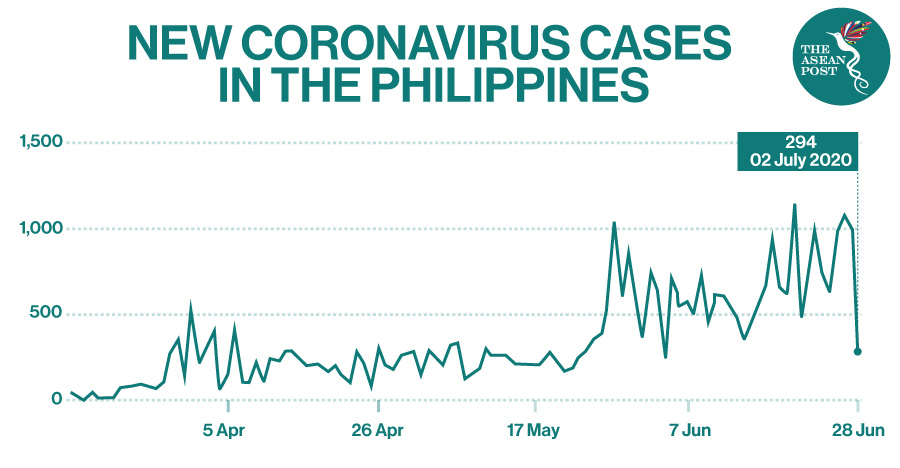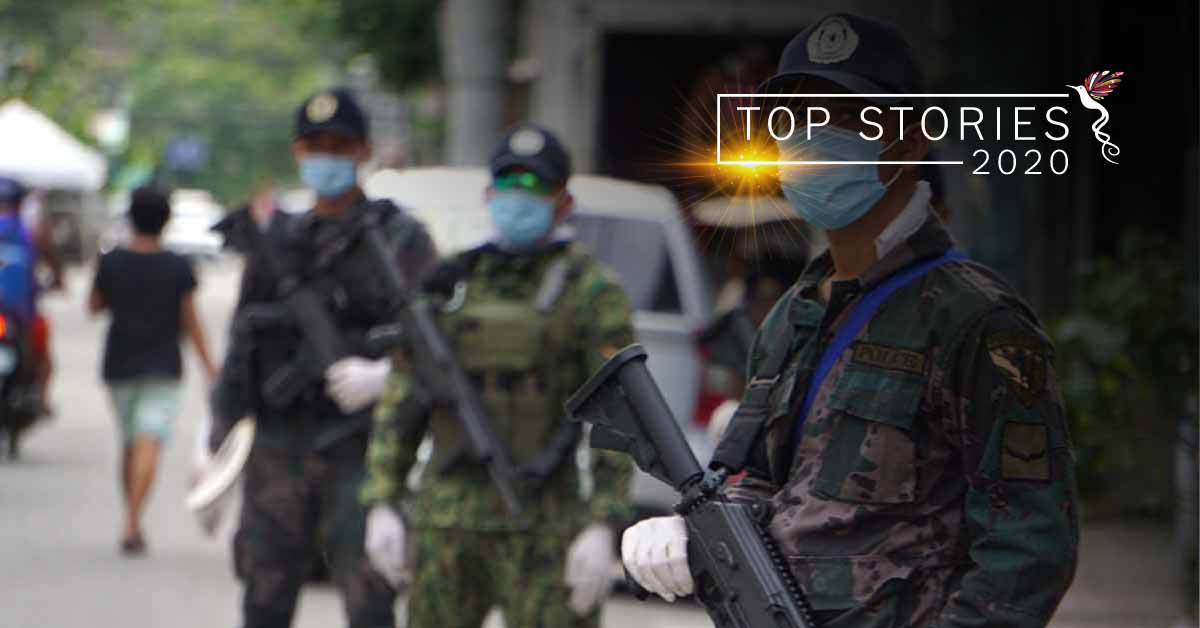After more than three months of hard lockdowns, the Philippines is now trying to ease out quarantine restrictions for its economy to bounce back. While the focus is on saving lives and looking after the health and well-being of every Filipino, developing economies like the Philippines with a population of around 109 million people – a high percentage of which come from hand-to-mouth households – simply cannot afford the use of containment measures like hard lockdowns for the entire country indefinitely. Hence, the government has considered steps to safely and gradually reopen the economy.
As the Philippines reopens its economy by easing out restrictions after successful lockdowns, it has experienced a reverse trend in the number of COVID-19 positive cases. The number of deaths has been reduced to single-digit, while the number of positive cases has increased significantly to three-digit.
This reversal is somewhat expected because more people are now back on the streets. One of the contributing factors to the rise in COVID-19 positive cases is the influx of returning Overseas Filipino Workers (OFWs), of which some have tested positive upon arrival in the Philippines. For instance, as of 2 July, out of the 99,353 returning OFWs, 2,424 were confirmed as being COVID-19 positive.
Likewise, the 30 June World Health Organisation (WHO) Philippines COVID-19 Situation Report, also stated that the higher number of cases in the past month was also in part due to: (a) enhanced surveillance, (b) the processing of backlog data; (c) real-time reporting through the mobile application COVID KAYA; and (d) expansion of the laboratory network for COVID-19 testing – allowing for a more realistic picture of the actual number of cases in the country.
The report further stated that the “national transmission assessment” for the Philippines remains in Stage 2 or “localised community transmission”, with data indicating an increasing trend, and likely higher transmission in the National Capital Region (NCR) and Central Visayas particularly Cebu city, with evidence of cases exported from these two regions to other areas with lower levels of transmission.
Silver Linings
Though the reverse trend in the number of positive cases is quite alarming, the COVID-19 situation in the Philippines is not all bleak. There are silver linings, which the country can capitalise on as it continues to fight the novel coronavirus. For instance, it is a fact that the Philippines is one of those countries which has: (a) the lowest deaths per one million population, and based on the WHO report mentioned earlier, the proportion of deaths has decreased to 3.4 percent (b) the country has one of the lowest total cases per one million population; and (c) it has a relatively low number of serious, critical COVID-19 patients.
Based on the Worldometer forecast, as of 3 July, 2020, the deaths/1M population was 12; the total positive cases/1M population was 368, and the number of serious critical cases is 166. Secretary Carlito Galvez of the National Task Force (NTF) on COVID-19 has claimed that more or less there is already a recovery rate of around 40-50 percent, which has not been reported, given that the number of recoveries declared are only of those who have been admitted to hospitals.
Another indicator suggesting that the COVID-19 situation is still manageable is the percentages for hospital beds and mechanical ventilator utilisation for COVID-19 patients. As of 2 July, just 46.57 percent of the 3,305 ward beds are occupied, while only 40.78 percent of the 9,330 isolation beds are occupied. The more comforting information is the fact that out of 1,341 Intensive Care Unit (ICU) beds, only 36.32 percent are occupied; while out of the 2,000 mechanical ventilators, only 22.45 percent are in use.

Another reassuring development is the fact that while the COVID-19 infection rate in the Philippines is fluctuating, it is also declining – from 20 percent (during the period when testing was limited) to roughly five percent now. According to the WHO, a five percent or lower positivity rate is an affirmative indicator that a country’s management of its COVID-19 cases is improving. However, the government of the Philippines must work harder to further reduce the positivity rate to below five percent if it wants to secure victory over the deadly COVID-19 virus.
The reproduction number (Rt) based on the latest data is Rt = 1.05 ± 0.03, which means each COVID-19 positive individual is infecting an average of just 1.05 persons. While reassuring, the goal is for Rt to be less than one and to sustain it. This would mean that, on average, an infected person is infecting less than one person, eventually stopping the transmission of the COVID-19 virus.
The lowering Rt trend is due to efforts in social/physical distancing, wearing face masks, Personal Protective Equipment (PPE), washing of hands, and other means to stop the spread of the virus. This shows that the prescribed minimum health standards by the government are not only vital but also effective in the country’s fight against the virus.
Realities And Responses
Like many countries in the developing world, the Philippines lacks hospital capacity, with a public health-care system that is in dire need of improvement, and this condition has been magnified many times over because of the pandemic. The country also has not much productive capacity for producing or manufacturing medical grade PPEs, medications used in the palliative care for COVID-19 cases, and other critical medical supplies and equipment like ventilators. These are just some of the realities that the country is confronted with in the advent of the novel coronavirus. Despite such a challenging situation, the Philippines was able to ramp-up its health-care capacity.
The total beds capacity dedicated to COVID-19 patients has increased from 13,557 as of 27 May to 13,976 on 2 July – an increase of around 419 beds. The dedicated beds for COVID-19 cases in Local Isolation and General Treatment Areas for COVID-19 Cases (LIGTAS-COVID Centers) as of 2 July was 50,532. There has also been an increase in the bed capacities of the Mega LIGTAS COVID facilities located both, in the NCR and Region III (Bulacan) from 1,348 beds as of 27 May, to 3,193 on 2 July – an increase of around 1,845 beds.
There was also an increase in the number of mechanical ventilators from 1,964 as of 27 May to a total of 2,000 mechanical ventilators – an increase of about 36 mechanical ventilators. The government was also able to stabilise the supply and demand for PPEs in the country. In terms of testing laboratory strengthening, as of 2 July, there are 74 licensed testing laboratories certified to conduct COVID-19 testing by the Department of Health (DOH).
50 laboratories are using Reverse transcription polymerase chain reaction (RT-PCR) technology and 20 laboratories are using GeneXpert, with an additional 173 public and private laboratories under assessment. This is quite a significant increase compared to just a single laboratory in March.
Likewise, the daily testing capacity of the country has also improved to 51,302 tests per day as of 19 June. As of 3 July, based on the Worldometer forecast, the actual number of total COVID-19 tests had reached 762,362, and the test per 1 million population was 6,957. This again is a huge improvement. But then again, the central challenge, which has not been overcome yet by the government is the maximisation of the daily testing capacity – the number of actual daily tests that are conducted.
As of 2 July, the total number of individuals tested daily was only 16,369, way below the country’s daily testing capacity. This is a persistent challenge for Health Secretary Francisco Duque of the DOH. Nonetheless, the government seems confident that it can assuage such a challenge with the recent arrival of one million polymerase chain reaction (PCR) test kits and 10 million test kits purchased by the Department of Budget and Management (DBM) and the DOH.
On the other hand, the contact tracer (CT) program of the government, which is critical in breaking the “chains of transmission” of the COVID-19 virus, is still weak. As of 18 of June, there were 54,042 CTs nationwide who are part of the 3,397 local “contact tracing teams” (CTTs), but only 21,341 are trained CTs. According to the WHO, the ideal contact tracer to population ratio is 1:800 to fully cover the over 109 million Filipinos. In effect, the country needs another 135,000 CTs.
The Department of Interior and Local Government (DILG) as lead agency of the government’s CT program, has proposed the hiring of around 50,000 CTs – as opposed to the estimated 82,537 CTs needed – to the Inter-Agency Task Force (IATF). It is expecting approval on its proposal soon to commence the hiring process. Though such an initiative is late in coming, it is still a much needed and welcome initiative.
Conclusion
While the Philippines is not yet in the same category of countries that have been remarkably successful in containing and eradicating the COVID-19 virus – like Vietnam and Thailand – the national response from the government has achieved relative success and is continuously being improved by the IAFT and policymakers. The national response of the Philippines against the novel coronavirus is a work in progress and is evolving. It is dependent on emerging realities on the ground and evolving knowledge about the virus.
Comparing the Philippines to other countries in terms of COVID-19 case doubling times and case fatality rates, and even in terms of success rates in the reduction of COVID-19 cases must be done with caution and utmost consideration of factors such as differences in healthcare system capacity, economic status, living conditions, population, and population density. These factors vary depending on the country.
Likewise, national responses (i.e. quarantine and health-related measures) of countries to their respective COVID-19 outbreaks, to a considerable degree, varies depending on their respective contexts. The pandemic’s impact on each country differs in some ways. However, benchmarking on what works and what doesn’t is important.
Hence, studying how other countries have managed and contained their outbreaks is immensely valuable, as the Philippines improves and re-adjusts its public health measures and strategies towards a more successful response to this global health crisis.
The Philippine government is facing a difficult balancing act of having to save lives and restarting the country’s economy. It must also continue to build health capacity, further expand its testing, tracing, isolation, and treatment programs, while ramping-up its health advocacy on the importance of practicing social distancing, wearing face masks, washing hands, and reminding people to be healthy and to maintain good hygiene practices.
All these measures are important to mitigate the spread of the virus, to reassure the public that new COVID-19 outbreaks like what is happening in Cebu City currently can be dealt with in an orderly fashion while minimising economic disruptions.
Articles selected as Top Stories of 2020 are those that were the most popular among readers of The ASEAN Post for the month in question.
Related Articles:

